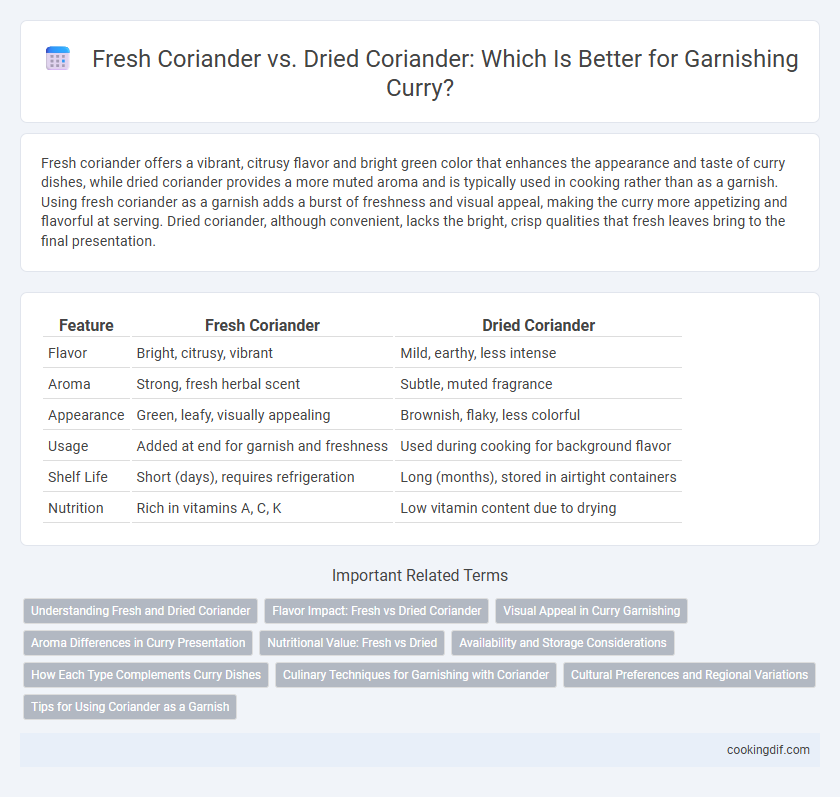Fresh coriander offers a vibrant, citrusy flavor and bright green color that enhances the appearance and taste of curry dishes, while dried coriander provides a more muted aroma and is typically used in cooking rather than as a garnish. Using fresh coriander as a garnish adds a burst of freshness and visual appeal, making the curry more appetizing and flavorful at serving. Dried coriander, although convenient, lacks the bright, crisp qualities that fresh leaves bring to the final presentation.
Table of Comparison
| Feature | Fresh Coriander | Dried Coriander |
|---|---|---|
| Flavor | Bright, citrusy, vibrant | Mild, earthy, less intense |
| Aroma | Strong, fresh herbal scent | Subtle, muted fragrance |
| Appearance | Green, leafy, visually appealing | Brownish, flaky, less colorful |
| Usage | Added at end for garnish and freshness | Used during cooking for background flavor |
| Shelf Life | Short (days), requires refrigeration | Long (months), stored in airtight containers |
| Nutrition | Rich in vitamins A, C, K | Low vitamin content due to drying |
Understanding Fresh and Dried Coriander
Fresh coriander offers a vibrant, citrusy flavor and a delicate texture that enhances the visual appeal and taste of curries. Dried coriander provides a more concentrated, earthy aroma and is typically used in powdered form to deepen the spice profile within the cooking process. Using fresh coriander as a garnish imparts brightness and freshness, while dried coriander contributes warmth and depth during cooking.
Flavor Impact: Fresh vs Dried Coriander
Fresh coriander imparts a vibrant, citrusy flavor with bright herbal notes that elevate the freshness of a curry, enhancing its aromatic complexity. Dried coriander lacks the lively aroma and tends to have a more muted, earthy taste, often used during cooking to infuse background warmth but less effective as a garnish. Using fresh coriander for garnish preserves its delicate oils and sharpness, creating an immediate, flavorful impact that dried coriander cannot replicate.
Visual Appeal in Curry Garnishing
Fresh coriander enhances the visual appeal of curry garnishing with its vibrant green color and delicate leaf texture, creating an inviting and appetizing look. Dried coriander, lacking the fresh leaves, offers minimal visual impact and can appear dull or pasty when sprinkled on curry. Using fresh coriander as a garnish not only highlights the dish's freshness but also adds a pop of color that improves presentation and stimulates appetite.
Aroma Differences in Curry Presentation
Fresh coriander provides a vibrant, citrusy aroma that enhances the overall sensory appeal of curry dishes, offering a lively, herbaceous note when used as a garnish. Dried coriander, while less aromatic, contributes a deeper, earthier scent that subtly complements the rich spices within the curry. The choice between fresh and dried coriander significantly impacts the final fragrance profile, influencing the visual and olfactory presentation of the curry.
Nutritional Value: Fresh vs Dried
Fresh coriander contains higher levels of vitamin C, antioxidants, and essential oils compared to dried coriander, making it more beneficial for boosting immunity and reducing inflammation. Dried coriander has a more concentrated flavor but loses much of its vitamin content and volatile compounds during the drying process. Including fresh coriander as a garnish enhances the nutritional profile of a curry, providing a richer source of micronutrients and phytochemicals.
Availability and Storage Considerations
Fresh coriander, also known as cilantro, is widely available in most grocery stores and markets but requires refrigeration and is best used within a few days to maintain its vibrant flavor and aroma. Dried coriander seeds or leaves have a much longer shelf life, often lasting several months when stored in an airtight container in a cool, dark place, making them a convenient option for long-term use. Availability of fresh coriander may be limited in certain seasons or regions, whereas dried coriander offers consistent accessibility year-round for garnish and seasoning in curry dishes.
How Each Type Complements Curry Dishes
Fresh coriander offers a vibrant, citrusy flavor and bright green color that enhances the freshness of curries, making it ideal for garnishing rich, creamy dishes like butter chicken or paneer tikka masala. Dried coriander, with its earthy and slightly nutty taste, works well in spiced curry blends for deeper layers of flavor when used during cooking or as a subtle garnish on robust, slow-cooked curries such as lamb rogan josh. Choosing fresh or dried coriander depends on the desired flavor intensity and appearance, as fresh leaves add visual appeal while dried seeds provide warmth and complexity to the overall dish.
Culinary Techniques for Garnishing with Coriander
Fresh coriander leaves provide a vibrant, aromatic finish when garnishing curries, delivering bright herbal notes and a crisp texture that dried coriander cannot replicate. In culinary techniques, fresh coriander is typically added just before serving to preserve its color and flavor, enhancing the overall presentation and palate. Dried coriander flakes or powder offer a subtler, earthier taste and are more suitable for cooking within the curry rather than as a garnish, where visual appeal and freshness are key.
Cultural Preferences and Regional Variations
Fresh coriander adds a vibrant, citrusy flavor preferred in Indian, Thai, and Mexican cuisines, enhancing dishes like curries and salsas with its aromatic leaves. Dried coriander is commonly used in Middle Eastern and North African cooking, offering a subtle, earthy taste primarily from seeds rather than leaves. Regional variations influence garnish choices, with fresh coriander favored in South Asian dishes for color and freshness, while dried coriander seeds enrich stews and spice blends in various global culinary traditions.
Tips for Using Coriander as a Garnish
Fresh coriander offers vibrant flavor and aroma, making it ideal for garnishing curries just before serving to preserve its bright, citrusy notes. Dried coriander lacks the fresh herb's intensity and is best incorporated into cooking rather than as a garnish. For an optimal presentation, finely chop fresh coriander leaves and sprinkle them over curries to enhance both visual appeal and taste.
Fresh coriander vs Dried coriander for garnish Infographic

 cookingdif.com
cookingdif.com